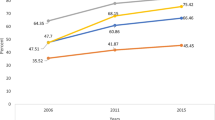Abstract
Adolescents and young adults are the fastest growing age group of human immunodeficiency virus (HIV) positive individuals in the US, and many who are infected do not know their HIV status. The HIV home test has the potential to help curb the HIV epidemic by improving detection of persons living with HIV and enabling them to seek follow-up care but it has not yet been evaluated in adolescents. Analogous to the home pregnancy test, which was met with much resistance and only successfully marketed during a time of social change, the HIV home test has been met with resistance since its FDA approval. This commentary summarizes the need to systematically evaluate positive and untoward/unanticipated effects of HIV home testing, particularly in young adults. The overall incidence of HIV has been declining in the US, yet it continues to grow at alarming rates for adolescents and young adults [1]. Almost 40 % of new HIV infections in the US are in this age group [2]. Further, many HIV infected adolescents and young adults are unaware of their infection. Nationwide, only 22.6 % of sexually active high school students have ever been tested for HIV [3]. While advances in drug regimens have transformed HIV into a chronic disease, infected individuals need to be identified and subsequently engaged in care [4].
Similar content being viewed by others
References
Prejean J, Song R, Hernandez A, Ziebell R, Green T, Walker F, et al. Estimated HIV incidence in the United States, 2006–2009. PLoS ONE. 2011;6(8):e17502.
Centers for Disease Control and Prevention (CDC). HIV surveillance in adolescents and young adults. Atlanda; 2012.
Centers for Disease Control and Prevention (CDC). HIV surveillance report; 2011.
Balaji AB, Eaton DK, Voetsch AC, Wiegand RE, Miller KS, Doshi SR. Association between HIV-related risk behaviors and HIV testing among high school students in the United States, 2009. Arch Pediatr Adolesc Med. 2012;166(4):331–6.
Phillips KA, Maddala T, Johnson FR. Measuring preferences for health care interventions using conjoint analysis: an application to HIV testing. Health Serv Res. 2002;37(6):1681–705.
Mandell BF. Home testing: the metamorphosis of attitudes about HIV infection. Clevel Clin J Med. 2012;79(10):669–74.
Walensky RP, Paltiel AD. Rapid HIV testing at home: does it solve a problem or create one? Ann Intern Med. 2006;145(6):459–62.
Badiee J, Moore DJ, Atkinson JH, Vaida F, Gerard M, Duarte NA, et al. Lifetime suicidal ideation and attempt are common among HIV+ individuals. J Affect Disord. 2012;136(3):993–9.
McNeil DG. Rapid HIV home test wins federal approval. New York: The New York Times; 2012, July 3.
Aryal N, Regmi PR, Mudwari NR. Violence against women living with HIV: a cross sectional study in Nepal. Glob J Health Sci. 2012;4(3):117–25.
Zierler S, Witbeck B, Mayer K. Sexual violence against women living with or at risk for HIV infection. Am J Prev Med. 1996;12(5):304–10.
Silverman JG, Decker MR, Saggurti N, Balaiah D, Raj A, et al. Intimate partner violence and HIV infection among married Indian women. J Am Med Assoc. 2008;300(6):703–10.
McNeil DG. Another Use for Rapid Home H.I.V. Test: Screening Sexual Partners. New York: The New York Times; 2012, October 5; Sect. Health.
Carballo-Dieguez A, Frasca T, Balan I, Ibitoye M, Dolezal C. Use of a rapid HIV home test prevents HIV exposure in a high risk sample of men who have sex with men. AIDS Behav. 2012;16(7):1753–60.
Elster A, Jarosik J, VanGeest J, Fleming M. Racial and ethnic disparities in health care for adolescents: a systematic review of the literature. Arch Pediatr Adolesc Med. 2003;157(9):867–74.
Shew ML, Hellerstedt WL, Sieving RE, Smith AE, Fee RM. Prevalence of home pregnancy testing among adolescents. Am J Public Health. 2000;90(6):974–6.
Fisher JD, Fisher WA, Misovich SJ, Kimble DL, Malloy TE. Changing AIDS risk behavior: effects of an intervention emphasizing AIDS risk reduction information, motivation, and behavioral skills in a college student population. Health Psychol. 1996;15(2):114–23.
Center for Disease Control and Prevention (CDC). HIV among Youth Atlanta, GA, 2011. Available from: http://www.cdc.gov/hiv/youth/pdf/youth.pdf. Accessed 2 Nov 2012.
Center for Disease Control and Prevention (CDC). HIV among Latinos Fact Sheet. Atlanta; 2011.
Paltiel AD, Weinstein MC, Kimmel AD, Seage GR 3rd, Losina E, Zhang H, et al. Expanded screening for HIV in the United States—an analysis of cost-effectiveness. N Engl J Med. 2005;352(6):586–95.
CDC. HIV among Latinos Fact Sheet. Atlanta; 2011.
Center for Disease Control and Prevention (CDC). What is a Diffusion of Effective Behavioral Intervention (DEBI)? 2012. Available from: https://www.effectiveinterventions.org/en/Home.aspx. Accessed 22 Apr 2013.
Shedlin MG, Decena CU, Oliver-Velez D. Initial acculturation and HIV risk among new Hispanic immigrants. J Natl Med Assoc. 2005;97(7 Suppl):32S–7S.
McNeil DG. Clinton in deal to cut AIDS treatment costs. New York: The New York Times; 2006.
Cianelli R, Ferrer L, McElmurry BJ. HIV prevention and low-income Chilean women: machismo, marianismo and HIV misconceptions. Culture, health & sexuality. 2008;10(3):297–306.
Gonzalez-Guarda RM, Vasquez EP, Urrutia MT, Villarruel AM, Peragallo N. Hispanic women’s experiences with substance abuse, intimate partner violence, and risk for HIV. J transcult nurs. 2011;22(1):46–54.
Peragallo N. Latino women and AIDS risk. Public Health Nurs. 1996;13(3):217–22.
Pagan K. Who Made That Home Pregnancy Test? New York: The New York Times; 2012, July 27; Sect. Design.
Acknowledgments
Dr. Rebecca Schnall is supported by the National Center for Advancing Translational Sciences, National Institutes of Health, through Grant Number KL2 TR000081, formerly the National Center for Research Resources, Grant Number KL2 RR024157. The content is solely the responsibility of the authors and does not necessarily represent the official views of the National Institutes of Health.
Conflict of interest
The authors have no conflicts of interest to report.
Author information
Authors and Affiliations
Corresponding author
Rights and permissions
About this article
Cite this article
Schnall, R., Carballo-Diéguez, A. & Larson, E. Can the HIV Home Test Promote Access to Care? Lessons Learned from the In-home Pregnancy Test. AIDS Behav 18, 2496–2498 (2014). https://doi.org/10.1007/s10461-014-0798-8
Published:
Issue Date:
DOI: https://doi.org/10.1007/s10461-014-0798-8




